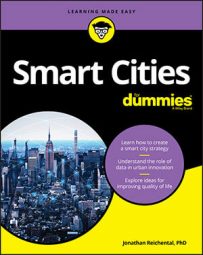Well done!
No, seriously. The decision to act on something, to take a particular path relative to the action itself, can be the hardest part. It’s always possible to become entrenched in debate, to fail to find common ground, or to reach an impasse. But once some form of agreement is reached, even if just marginally directional, you should celebrate.
 ©Shutterstock / Krunja
©Shutterstock / KrunjaAnyone who has worked on a project of some significance knows the difference between the big decisions and the many small decisions that happen. Without those big decisions, the project team might struggle. But it’s a great relief when direction is given. The project team can then move ahead with their work.
One of the most important big decisions that has to be made at the beginning of a smart city effort is the establishment of a vision or vision statement. This vision is a top-level guide for almost all decisions to come.
Singularity University has a term for efforts with a bold vision that motivates meaningful change. It’s called massive transformative purpose (MTP). An MTP is aspirational and focused on creating a different future. Realizing an MTP requires a mindset and work environment that leans into complex problems and strives to think big. MTP needs talented and dedicated teams working smartly with a huge amount of motivation.
They have successes and sometimes failures. Creating a smart city may not be the equivalent of finding cures for all types of cancer, but the outcomes of smart city efforts are significant and can impact a lot of people. Consider your vision exercise as your MTP.
The smart city movement remains largely in its infancy. The vast majority of cities in the world have yet to embark on this journey (assuming that it’s the right direction for many of them). They are starting from zero. As with any initiative, it’s easy to jump directly into the tactics after receiving direction to pursue smart city goals. But that would be a mistake.
The first step on any smart city journey needs to be the establishment of an agreed-on vision. That vision guides strategy, and strategy directs the work.
Identifying the role of leadership for your smart city
Leadership and management are terms that are often used interchangeably. That’s a mistake. Although there are some underlying similarities, they are different. Each requires and utilizes a specific approach and mindset.Management is doing things right.
Leadership is doing the right things.
It’s an essential distinction attributed to the management guru Peter Drucker. It’s one of the reasons that management can be learned, but leadership has qualities that some fortunate people possess from birth and can’t be easily acquired by training — such as charisma.
Sure, many aspects of leadership can be learned, but it’s obvious that remarkable leaders don’t necessarily acquire their skills from books. It’s a little frustrating for those trying to be great leaders when they realize that they can learn and practice most skills but will always have a deficit relative to those unique leadership qualities that require something special.
That said, the body of knowledge today on leadership is enough to help most leaders acquire the essential skills. Any given leadership team will have some with learned skills and some with natural abilities. That’s the case on city leadership teams, too.
Smart city work suffers without great leadership. After all, research from across all industries suggests that projects generally succeed or fail depending on the availability of consistent high -quality leadership support.
Who are these city leadership teams, and what might their responsibilities be relative to smart city work? To answer these questions, city leadership has been divided into these four basic parts:
- Elected leaders: Assuming some form of democratic process, these leaders, which can include the popular role of mayor, are chosen by the city’s constituents via voting and serve for a predetermined period. This is by far the most common process. In some jurisdictions around the world, city leaders are appointed by other bodies. In either case, these leaders typically have the primary function of setting policy, approving budgets, and passing legislation. They may originate an issue to debate, or an issue may be brought to them by any number of stakeholders, from community members to city staff.
For example, if city staff proposes the smart city effort, elected officials are responsible for suggesting modifications, requesting more information, and approving or declining the request. Elected leaders absolutely must sign off on the smart city effort — particularly the vision, goals, and, ultimately, budget. A healthy public debate by elected leaders on the merits of the smart city work is valuable, as is eliciting public comment.
- Appointed leaders: Running a city on a day-to-day basis requires a set of hired leaders. The city inevitably has some form of overall leader — the public agency equivalent of a chief executive officer (CEO), such as a city manager or city administrator. This leader has assistants, deputies, and an executive team that manages the various areas of the city. These areas may include transportation, public works, planning, energy, libraries, healthcare, technology, and many more. Big cities have a large number of managed areas.
The city leader and the team have the primary responsibility to implement and maintain policies. They make daily decisions and ensure that the city is operational and responsive to community needs. These leaders also propose initiatives to elected officials. A smart city effort may originate this way. It’s also possible, for example, that a strong mayor will ask for staff to develop a smart city plan and propose it to the elected leaders for approval. Appointed leaders are accountable to elected leaders and, by extension, to the community.
- Leadership support and oversight: In this category, a small leadership team is tasked with originating a draft policy, recommendations, or other decision-making instruments on behalf of either the elected or appointed leaders. These teams, which have a guiding function, aren’t decision-making bodies. However, they are essential contributors toward city leadership. These teams can be permanent or temporary, depending on their function.
For example, the elected leaders may opt to create a committee to oversee and make recommendations and provide reporting oversight on the efforts of a smart city initiative. The team may exist only as long as the smart city initiative continues. Alternatively, a city may have a permanent transportation committee whose role is to make recommendations on matters related to transportation. Because this area is often included in smart city work, it may be the body that’s approached for leadership input. These teams are typically made up of suitably qualified members of the community.
- Regulatory leadership: This category is a broad one, in order to capture a range of other leaders who may have input in a city’s decision-making process. The most obvious groups include those who make regulations at a regional or national level. For example, a national set of rules on how drones can be deployed in cities may be made by a leadership group outside of a particular city, but that city would be required to adhere to the rules. This can make sense so that all cities in a region or country follow the same set of rules.
People often debate how much power a city should have over its operations relative to the power of those at the regional or national level. Cities clearly want as much autonomy as possible, but the benefits of standards at a national and even global level have important merit as well. An example of an area where a city can benefit from national decision-making in the smart city domain is telecommunications. A national commitment to supporting infrastructure standards, and also financial assistance, benefits everyone. An example of global leadership is managing the climate crisis. Even though cities and nations have to sign on, the leadership and guidance may come from a global entity.
Creating a vision for your smart city
Your city has decided to embark on a smart city journey. Great! Now it’s time to create a vision or vision statement. What is a vision, and how is it created?Here, you’ll see vision and vision statement used interchangeably. There’s little difference between them, other than the number of words. A vision generally takes a few paragraphs to describe. A vision statement is typically only a few words long. The intent is identical.
A vision is a statement of what you desire the future to be. It’s not tactics or operations. It’s not projects or deliverables. It’s simply a statement that guides the development of a strategic plan — called the envisioning process — and the decisions made throughout the journey.
To help you better understand the role of a vision in the strategic plan, let’s take a quick look at strategic planning:
Strategic planning is the systematic process of envisioning a desired future and translating this vision into broadly defined goals or objectives and a sequence of steps to achieve them.
Put another way, the strategic plan is the translation of a strategic vision into outcomes.
A vision written correctly and agreed on by relevant stakeholders holds the initiative accountable and provides essential guidance in times of uncertainty. Though it’s easy to overlook or omit this step, its value can’t be overstated. Do it. You’ll be happy you did.
A vision isn’t the same as a mission. An organization's mission is what it does and how it does it, and it includes its shorter-term objectives. Your vision is none of those things. It’s long-term and future-oriented, and it describes a big-picture future state. It has clarity and passion.Here are ten tips for creating an outstanding vision statement:
- Think long-term.
- Brainstorm what a big future outcome would look like. Choose the one that gains consensus.
- Use simple words. Don’t use jargon.
- Make the statement inspiring.
- Ensure that the entire vision statement is easy to understand.
- Eliminate ambiguity. Anyone should be able to have a common understanding of what's actually involved.
- Consider making the statement time-bound. For example, use language such as “By 2030 . . .”
- Allude to organizational values and culture.
- Make the statement sufficiently challenging that it conveys a sense of ambition and boldness
- Involve many stakeholders.
- Ben & Jerry's: "Making the best ice cream in the nicest possible way."
- Habitat for Humanity: "A world where everyone has a decent place to live."
- Caterpillar: "Our vision is a world in which all people's basic needs — such as shelter, clean water, sanitation, food and reliable power — are fulfilled in an environmentally sustainable way, and a company that improves the quality of the environment and the communities where we live and work."
- Hilton Hotels & Resorts: "To fill the earth with the light and warmth of hospitality."
- Samsung: "Inspire the world, create the future."
- Smart Dubai: “To be the happiest city on earth.”
- Safe city: Leverage technology to make San José the safest big city in America.
- Inclusive city: Ensure that all residents, businesses, and organizations can participate in and benefit from the prosperity and culture of innovation in Silicon Valley.
- User-friendly city: Create digital platforms to improve transparency, empower residents to actively engage in the governance of their city, and make the city more responsive to the complex and growing demands of the community.
- Sustainable city: Use technology to address energy, water, and climate challenges to enable sustainable growth.
- Demonstration city: Reimagine the city as a laboratory and platform for the most impactful, transformative technologies that will shape how people live and work in the future.

